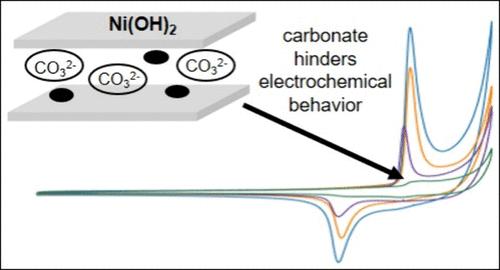Carbonate Formation during Nickel Hydroxide Precipitation Reduces Pseudocapacitive Performance
IF 7
2区 材料科学
Q2 CHEMISTRY, PHYSICAL
引用次数: 0
Abstract
Nickel hydroxide (Ni(OH)2) is a promising pseudocapacitive material owing to its high theoretical capacitance and reversible Ni2+/Ni3+ redox activity. Here we demonstrate that carbonate incorporation during hydrothermal synthesis is the key structural factor limiting its electrochemical performance. Ni(OH)2 was prepared using hexamethylenetetramine (HMT) and urea at different synthesis temperatures, and carbonate incorporation was quantified by XRD, FTIR, Raman, TGA-MS, and CaCO3 precipitation. HMT-derived samples at a low temperature (80 °C) formed a turbostratic α-phase with interlayer water, delivering the highest specific capacitance (∼870 F g–1 at 1 A g–1) and excellent cycling stability (92–96% retention after 1000 cycles). In contrast, increasing the synthesis temperature promoted carbonate incorporation and crystallization into nickel carbonate hydroxide, reducing the interlayer spacing and surface area and increasing charge-transfer resistance. Urea-derived samples incorporated carbonate at all synthesis temperatures, yielding phases with capacitances an order of magnitude lower than those of HMT analogues. Electrochemical impedance spectroscopy confirmed that carbonate incorporation blocks redox-active sites and hinders ion/electron transport. These results provide a quantitative mechanistic understanding of how carbonate formation governs transition metal layered hydroxide performance, establishing guidelines for optimizing hydrothermal synthesis of pseudocapacitive electrodes.

氢氧化镍沉淀过程中碳酸盐的形成降低了假电容性能
氢氧化镍(Ni(OH)2)具有较高的理论电容和可逆的Ni2+/Ni3+氧化还原活性,是一种很有前途的赝电容材料。研究表明,水热合成过程中碳酸盐的掺入是限制其电化学性能的关键结构因素。以六亚甲基四胺(HMT)和尿素为原料,在不同的合成温度下制备了Ni(OH)2,并通过XRD、FTIR、Raman、TGA-MS和CaCO3沉淀法对Ni(OH)2的碳酸盐掺入进行了量化。hht衍生的样品在低温(80°C)下形成具有层间水的涡轮α-相,具有最高的比电容(在1 a g-1时约870 F g-1)和优异的循环稳定性(1000次循环后保持92-96%)。升高合成温度有利于碳酸盐的掺入和结晶,减少了层间间距和表面积,增加了电荷转移电阻。尿素衍生的样品在所有合成温度下都含有碳酸盐,产生的相的电容比HMT类似物低一个数量级。电化学阻抗谱证实,碳酸盐的掺入阻断了氧化还原活性位点,阻碍了离子/电子的传递。这些结果提供了碳酸盐形成如何影响过渡金属层状氢氧化物性能的定量机制理解,为优化水热合成假电容电极建立了指导方针。
本文章由计算机程序翻译,如有差异,请以英文原文为准。
求助全文
约1分钟内获得全文
求助全文
来源期刊

Chemistry of Materials
工程技术-材料科学:综合
CiteScore
14.10
自引率
5.80%
发文量
929
审稿时长
1.5 months
期刊介绍:
The journal Chemistry of Materials focuses on publishing original research at the intersection of materials science and chemistry. The studies published in the journal involve chemistry as a prominent component and explore topics such as the design, synthesis, characterization, processing, understanding, and application of functional or potentially functional materials. The journal covers various areas of interest, including inorganic and organic solid-state chemistry, nanomaterials, biomaterials, thin films and polymers, and composite/hybrid materials. The journal particularly seeks papers that highlight the creation or development of innovative materials with novel optical, electrical, magnetic, catalytic, or mechanical properties. It is essential that manuscripts on these topics have a primary focus on the chemistry of materials and represent a significant advancement compared to prior research. Before external reviews are sought, submitted manuscripts undergo a review process by a minimum of two editors to ensure their appropriateness for the journal and the presence of sufficient evidence of a significant advance that will be of broad interest to the materials chemistry community.
 求助内容:
求助内容: 应助结果提醒方式:
应助结果提醒方式:


